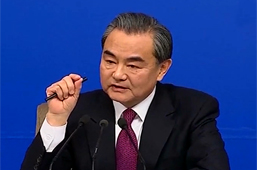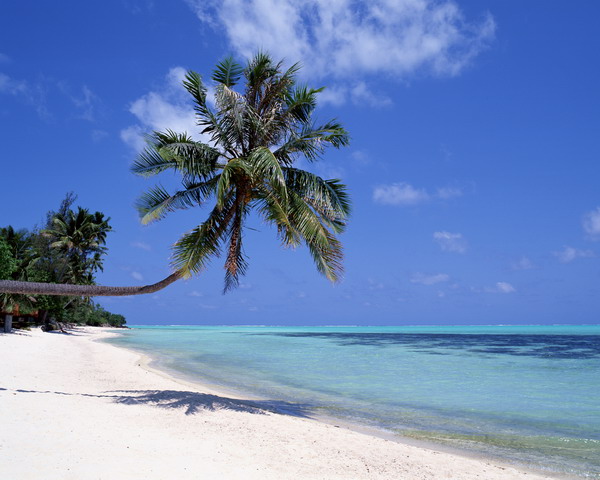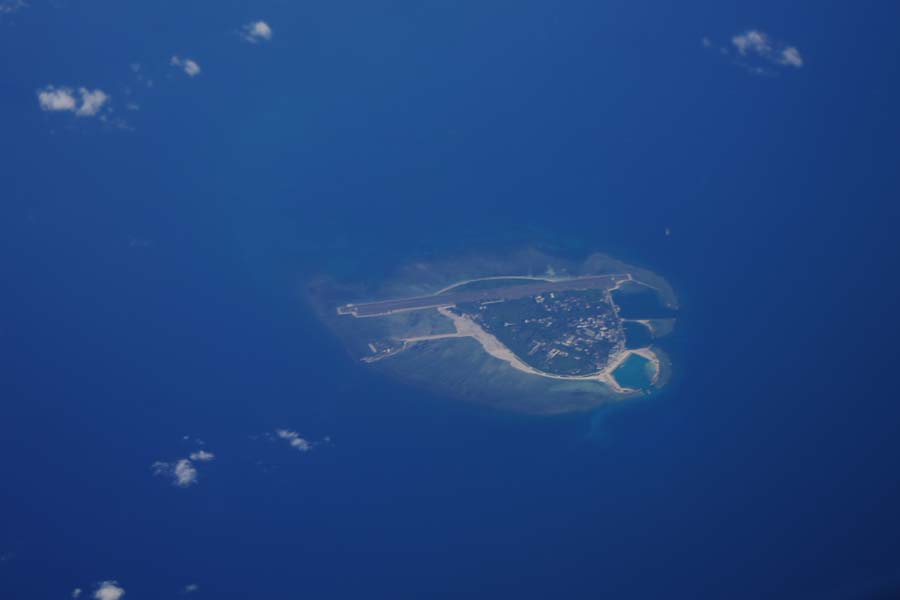1) Construction of Facilities
Livelihood infrastructure: On May 15, 1950, the Chinese People's Liberation Army landed on Yongxing Dao in Xisha Qundao. In April 1956, Guangdong Province and Hainan Administrative Region jointly organized an aquatic resources investigation team for Xisha Qundao and Nansha Qundao, set up a center station on Yongxing Dao. Supply and marketing cooperatives, clinics, clubs and power stations were built successively to satisfy the needs of the over 200 people stationed there.
Meteorological facilities: On July 1, 1957, Xisha Weather Station of Guangdong Province was established in Xuande Road, Yongxing Dao. Later, it was renamed Guangdong Provincial Weather Station for Xisha, Nansha and Zhongsha Qundao in February 1975. From April to June 1987, the Chinese government organized a number of departments to the waters of Nansha Qundao and surveyed dozens of islands and the adjacent waters for establishing an Ocean Observatory there, ultimately choosing Yongshu Jiao as the site. From January to February 1988, the engineering units of the PLA and the escort formation raised the first five-star red flag, the national flag of China, on Yongshu Jiao, officially started construction of the ocean observatory. The subsequent victorious battle fought on Chigua Jiao ensured the smooth process of the project. On August 2, the Ocean Observatory of Yongshu Jiao, the first ocean observatory built by China on Nansha Qundao, was completed. It began to send monthly average water level data to the International Ocean Observing System of the UNESCO Intergovernmental Oceanographic Commission.
Transport facilities: In September 1979, corps under the Chinese Navy began to build two permanent lighthouses on Langhua Jiao and Beijiao Jiao in Xisha Qundao. On July 18, 2013, Phase 1 of Yongxing Comprehensive Terminal in Sansha City, the first large-scale civil wharf project in the South China Sea, was delivered, with a total of nine berths, after three years of construction. Three berths are to be added in the second phase of construction. On March 14, 2014, a meeting was convened in Haikou by the Navigation Center for the South China Sea, Ministry of Transport, and the decision for establishing navigation aid offices in Xisha Qundao and Nansha Qundao was formally announced. On August 4, 2014, the Navigation Center for the South China Sea, Ministry of Transport, conducted a field survey and determined the sites for lighthouses (piles) on Beijiao Jiao, Lingyang Jiao (Kuangzai Sandbar), Jinqing Dao, Nansha Sandbar and Gaojianshi Jiao in the waters of Xisha Qundao. On June 12, 2015, tower cranes were installed and raft foundation completed for the two lighthouses situated on Huayang Jiao and Chigua Jiao in Nansha Qundao. Measuring 50 meters each, the two multi-function lighthouses were equipped with 4.5-meter lanterns, and a large rotating lamp as the main light with a designed illumination range of 22 nautical miles. An AIS Base Station and VHF Base Station were also scheduled be built at the same sites. On August 4, 2015, the staff of Xisha Navigation Aid Office stationed on Yongxing Dao placed two emergency light buoys, one red and one green in the channel of Zhaoshu Dao under the jurisdiction of Sansha City, Hainan Province for guiding ships sailing to and from the island and for avoiding the reefs.
On January 6, 2015, "Sansha No. 1", the first communication supply vessel built after the establishment of Sansha City arrived in Yongxing Dao and successfully completed its first operation. Capable of all-weather navigation and sailing under force-eight winds, the vessels had an endurance capacity for supplying transportation and administrative management in Xisha, Nansha and Nansha Qundao. On October 9, 2015, the lighting ceremony was held for Huayang Lighthouse and Chigua Lighthouse, the two large multifunctional lighthouses built by the Chinese Ministry of Transport on Huayang Jiao, indicating their official commissioning. On January 2, 2016, Hua Chunying, the spokeswoman of the Chinese Ministry of Foreign Affairs said in a press conference regarding proving flights of China on Yongshu Jiao that civil engineering of the airport on Yongshu Jiao had been completed, and that the Chinese government had expropriated civil aircraft for proving flights to determine whether the airport facilities met the standards of civil aviation. China conducted proving flight on Yongshu Jiao of Nansha Qundao.
Communication facilities: In March 1959, the Guangdong Post and Telecommunication Administration established the Post Office of Xisha, Nansha and Zhongsha Qundao, to provide postal and telecommunications services for those islands. After the establishment of Hainan Province, the office was renamed the Post Office of Xisha, Nansha and Zhongsha Qundao, to provide letter and parcel delivery, newspaper subscription, foreign exchange and correspondence service for compulsory servicemen, as well as other postal and telecommunications services. On October 1, 1988, a post office was established on Nansha Qundao, at the notice from the Hainan Provincial Posts and Telecommunications Authority, the Central Military Commission and the Ministry of Posts and Telecommunications. Named Nansha Post Office, it was officially commissioned on November 1 of the same year, becoming the southernmost post office in China. In June 2014, Sansha Branch of Hainan Provincial Postal Company was officially established to provide postal and communications services for the garrison and civilians of Sansha City. Its establishment ensured quality delivery of letters and parcels and remittance for the city, and met the needs of special communication tasks such as confidential communications, CPC newspaper distribution and correspondence for compulsory military staff. On January 1, 2016, Sansha Post Stations, a post of the "Maritime Silk Road," was established by Sansha Branch of China Post Group. In addition to postal and communication services for the garrison and residents of Yongxing Dao, as well as tourists visiting the island, it also provided DIY postcard printing service.
On February 1, 2015, Guangzhou Coastal Radio of Maritime Security Center for the South China Sea under the Ministry of Transport started trial NAVTEX broadcasting services at frequency of 4209.5 kHz. Information released included weather forecast, typhoon warning, navigational warning, sea state, search and rescue information and other maritime safety information 6 times a day in English, for areas within the range of about 500 nautical miles, covering the waters of Xisha Qundao, Zhongsha Qundao and Huangyan Dao. In December 2015, the People's Government of Sansha and China Mobile Group Hainan Co., Ltd. jointly launched the ship-borne mobile communication project on the Vessel "Sansha No. 1." In 2016, the communication and supply vessel realized the maritime mobile communications network coverage between Qinglan Port of Wenchang and Yongxing Dao.
Fisheries facilities: In 1995, China built fishery shelter facilities on Meiji Jiao in Nansha Qundao, and placed them under the control of Nanhai District Administration of Fishery and Fishing Harbor Supervision under the Ministry of Agriculture.
In August 2007, the positioning system for fishing vessels in Nansha Qundao was basically completed. A total of 11 ground monitoring stations were built and satellite monitoring terminals were installed on over fishing vessels. Based on the independent design of China and Beidou Satellites with independent intellectual property rights, the positioning system is a communications positioning system developed by utilizing computer network communication, geographic information system and management information systems and other technologies. It is capable of accessing the position information of vessels, automatic early warning, alarming, command scheduling, two-way text communication, management of fishing vessel archives, and communication between the vessels and bases on the shore.
Planning for future construction: On June 16, 2015, Lu Kang the spokesman of the Chinese Ministry of Foreign Affairs announced that dredger reclamation on some of the islands and reefs in Nansha Qundao stationed with Chinese troops would be completed soon and that construction projects on islands and reefs in Nansha Qundao were intended to satisfy all kinds of civil needs and to better perform such international obligations as maritime search and rescue, disaster prevention and mitigation, marine scientific research, meteorological observation, ecological environment protection, navigation safety, services to fisheries, aside from needs for basic military defense.
2) Development and Management of Oil, Gas and Fishery Resources
(1) Oil and Gas Resources
On June 25, 2012, China National Offshore Oil Corporation (CNOOC) announced that nine offshore blocks in the South China Sea region should be open to cooperation with foreign companies for exploration and development. The spokesperson of Chinese Ministry of Foreign Affairs said that announcing oil and gas blocks in the South China Sea for tendering by Chinese companies was a normal business practice consistent with the relevant Chinese laws and international practices. On August 28, CNOOC announced the second batch of China's maritime blocks to be opened in 2012. Among the total of 26 blocks for cooperation with foreign companies, 22 were located in the South China Sea.
On November 5, 2014, CNOOC announced that the first thousand-meter well undertaken by "Nanhai No. 9" in the South China Sea had been successfully completed, and "Nanhai No. 9" had become the second rig to enter the "deep-drilling club of 1,000 meters" following "Offshore Oil 981."
In 2014, China began to implement "Liwan-3" Oil And Gas Project and tap natural gas resources in the waters of the South China Sea about 325 km away from Hong Kong. On April 1, one senior executive at Husky Energy, a participant in running the project, said that the deep-water areas in the northern section of the South China Sea had huge natural gas prospects and were in the early stages of development.
On December 2, 2015, China National Offshore Oil Corporation announced that China's first ultra-deepwater well Lingshui 18-1-1 undertaken by "Offshore Oil 981" in the South China Sea witnessed successful test operation, with an actual drilling depth of 2,927 meters.
(2) Fishery Resources
In 1985, the Ministry of Agriculture organized fishermen to resume fishery production in Nansha Dao. Over 20 years, the fishing vessels operating in Nansha Qundao increased from 13 in 1985 to over 600 in 2009, exceeding 900 at the peak. Correspondingly, the catch increased from 4 tons to nearly 50,000 tons. In 2007, support was offered to encourage enterprises for cage culture around Meiji Jiao. Fishery production evolved from monotonous diving and fishing to combined fishing methods including trawling, seining and harpooning. The scope of fishery production was also expanded from the vicinity of the reefs to fisheries in the southwest. Fishing boats of Guangxi were early players in developing fishery resources of Nansha Qundao. In the 1970s, fishing vessels from state-owned fishery companies of Guangxi began sailing to the waters of Nansha Qundao for fishing production. Organized development of fisheries there began from 1989 onwards, with gradually expanded production scale after 2000. At its early stages, fishing in Nansha Qundao was mainly trawl-based within the area between latitude 4°and 9°. After 2010, the proportion of nets fishing nets to Nansha Qundao increased year by year, the operation area mainly between the 8°N and 17°N. At present, there are nearly 100 large-scale fishing vessels operating all year round in the waters of Nansha Qundao. According to statistics, from 1989 to 2011, Guangxi organized a total of 2,300 fishing vessels to Nansha Qundao for fishing production, with a catch of 250,000 tons and output value of RMB 1.3 billion.
On March 5, 1999, the Ministry of Agriculture issued the "Notice on Implementing Summer Fishing Moratorium Season in the South China Sea Waters", deciding that fishing moratorium shall be exercised from 1999 onwards from zero o'clock of June 1 to 24 o'clock of July 31 each year in waters to the north of 12°N (including Beibu Bay). During the season, all operations with fishing trawls (including those for shrimp and shellfish), seining and dredging should be banned. That was the first time for China to implement a summertime fishing ban in the South China Sea. From 1999, China had abided by the regulation, aside from strengthening ecological and fishery protection there. By the end of 2015, six state-class aquatic biological nature reserves and six provincial aquatic biological reserves had been built in the South China Sea, covering 2.69 million hectares in total, as well as seven national aquatic germ plasm resources conservation zones, covering 1.28 million hectares in total.
On January 1, 2004, Regulations for Fisheries Management in Nansha Qundao formulated by the Ministry of Agriculture was implemented, offering systematic guarantee for strengthening fishery management and maintaining the order of fishing in Nansha Qundao management basis. From January 2004 on, the Fishery Administration of the South China Sea under the Ministry of Agriculture launched comprehensive training for fishermen from Guangdong, Guangxi, Hainan Provinces and Hong Kong SAR to facilitate their operations in Nansha Qundao. By the beginning of March, the training courses had been extended to over 900 fishermen and grass-roots management personnel with 6 training sessions held in Taishan of Guangdong, Beihai of Guangxi, Qionghai of Hainan, and Hong Kong SAR.
In April 2005, the Fishery Administration of the South China Sea made arrangements for issuing special fishing licenses for Nansha Qundao according to Regulations for Fisheries Management in Nansha Qundao, and decided that annual examination and approval for special fishing licenses would be continued for the year 2005. All applications must be made before June 30, 2005, after which no application would be handled. According to the original plan, all fishing licenses were to be renewed in the first half of 2005, but were delayed for some reason. For adjustment and addition of applications for fishing operation in Nansha Qundao, the new version of the special fishing license application should be filled out and reported to the higher authority level by level. For fishing vessels guilty of cross-border production, capture of protected aquatic wild animals, blast fishing and poison fishing or carrying explosives to the sea or violating laws and regulations in other manner over the past two years, the fishery administrative departments at all levels should refuse review their applications. Fishing vessels holding valid special fishing licenses for fishing in Nansha Qundao shall fill in the fishing log truthfully during their operations there and hand it in to the competent fishery administrative department, which shall submit the collected fishing log to the Nansha Fisheries Service of the South China Sea Bureau as required. Failure to fill in the fishing log according to regulations shall mean curtailed preferential treatment according to the circumstances. In the same month, the Nanhai District Fisheries Administration of the Ministry of Agriculture also organized the fishery administrative departments of Guangdong, Guangxi and Hainan, as well as Migrant Fishermen Office of Guangdong, Hong Kong SAR and Macao SAR to comprehensively investigate the fishing vessels (including migrant fishing vessels of Hong Kong SAR and Macau SAR) involved in the Foreign-related Fishing Incident of 2004, focusing on their implementation of Regulations for Fisheries Management in Nansha Qundao.
In June 2005, Nanhai District Administration of Fishery and Fishing Harbor Supervision under the Ministry of Agriculture specifically prepared Fishing Log in the Waters of South China Sea and distributed it to relevant fishery production units in Guangdong, Guangxi and Hainan, in order to strengthen management of fishery production in Nansha Qundao and effectively control its dynamic changes. 32 folios in size, the log consisted of two versions, including one for trawling and seining and the other for harpooning and angling. It was requested by Nanhai District Administration of Fishery and Fishing Harbor Supervision that all fishing vessels truthfully fill in the fishing log, including the operating time, operating area, catch varieties, catches quantity and net parameters, and hand in their respective log to the fishery administrative department of the locale where they were registered. In the end of November each year, the fishery administrative departments shall hand over all the collected logs to Nansha Fishery Division of the Fishery Bureau of Nanhai District.
In 2007, the Fishery Bureau of Nanhai District under the Ministry of Agriculture organized fishermen operating in Nansha Qundao to carry out productive cage culture project in Meiji Jiao. After more than two years of experiment and exploration, preliminary success was obtained in productive cage culture in tropical reef lagoons. In November 2009, the first batch of fish was harvested, including 2,192 blotchy rock cod, 64 Miniatus Groupers, and one grouper weighing 30 kilograms and other economic fish. The initial success in cage culture at Meiji Jiao filled the gap in China's tropical culture around coral reefs.
On September 19, 2008, the "Treasure the Turtles and Protect the Oceans"—2008 Mobilization cum Inauguration Meeting for the Special Action of Turtle Protection in Nansha Qundao was jointly held by Nanhai District Administration of Fishery and Fishing Harbor Supervision, and Hainan Provincial Department of Ocean and Fisheries and Qionghai Municipal People's Government in the People's Government of Tanmen Town, Qionghai City, Hainan Province, officially unveiling the three-month special action for protecting turtles in the South China Sea.
At the end of 2008, Hainan Provincial Fisheries Research Institute launched a survey to determine winter fish resources in Nansha Qundao, including a one-month study of the fish resources in the waters of Zhubi Jiao, Nanxun Dao, Dongmen Dao, Meiji Jiao, Chigua Jiao, Yongshu Dao and Huayang Dao. In the survey, data of the species, dominant taxa and distribution characteristics of the economic fish in the waters adjoining coral reefs were obtained. The survey project was approved by an expert panel of the Ocean University of Guangdong in 2009. On April 9, 2010, the Hainan Provincial Fishery Research Institute and Yufeng Professional Fishermen Cooperative of Sanya City jointly launched a survey of pelagic fish resources in Nansha Qundao. Liu Wei and Fu Yifan, two experts from the Fisheries Research Institute, conducted a field trip of 20 days together with more than 40 fishermen. By collecting the enrichment area of the reef fish resources in Nansha Qundao, the annual production and development potential of pelagic fish resources were evaluated and specific measures were put forward for the development and management of fishery resources in the adjoining waters, providing a scientific basis for fisheries development planning by the supervisory departments in Guangdong, Hainan and Guangxi.
On December 7, 2013, "Nanfeng", a fishery survey ship of the South China Sea Fisheries Research Institute of the Chinese Academy of Fishery, arrived in Guangzhou after the fourth survey mission of the waters of Nansha Qundao in 2013, putting an end to the survey tasks in the area for 2013. A total of four survey missions had been arranged for "Survey and Evaluation of Fishery Resources in the South China Sea", a project undertaken by the South China Sea Fisheries Research Institute in 2013. The fourth survey lasted 30 days, from November 8 to December 7, covering 4,746 nautical miles and completing the investigation of fishery resources, environmental elements and biological elements of 46 stations. The four survey voyages of the entire year totaled 138 days and covered 210,000 nautical miles, reaching Zengmu Ansha at 3°58'N at the farthest point. The survey covered Nansha Qundao and about 600,000 square kilometers of adjoining waters.
On January 1, 2014, Amended Act of Hainan Province for Implementing "Fisheries Law of the People's Republic of China" entered into force, regulating that foreign nationals and fishing vessels entering into the waters under the jurisdiction of Hainan Province for fishing operations or fishery resources investigation shall abide by the laws, regulations and the relevant provisions of Hainan Province concerning fishery, environmental protection and exit and entry administration in China.
On April 20, 2016, "Nanfeng", a fishery survey ship of the South China Sea Fisheries Research Institute of the Chinese Academy of Fishery, arrived in Guangzhou after a comprehensive fishery survey of the waters of central and southern sections of the South China Sea, including Xisha Qundao, Zhongsha Qundao and Nansha Qundao. That was the first (spring) survey in implementing the special project of "Fishery Resources Survey and Assessment of the South China Sea" under the Ministry of Agriculture for the year 2016. The ship set sail on March 22 and started the returning trip on April 20, covering 4,200 nautical miles within the duration of 30 days. Through joint operation of "Nan Feng" and a light net fishing vessel, the fishery investigation and resource exploration of the key fishing grounds and the reef lagoon areas in the waters of "Xisha, Nansha and Zhongsha Qundao" in the South China Sea were completed. A great deal of valuable data and information was obtained, covering fishery resources, the environmental factors and biological elements of fisheries, fishing technology, ecosystems of the islands and reefs, the marine biological genetic diversity and the sample collection of the biological mass in 43 stations across 8 cross sections.
3) Development and Management of Tourism Resources
On December 26, 1978, the passenger and cargo shipping routes between Hainan Island and Xisha Qundao were officially put into operation. On January 4, 2010, the State Council of the People's Republic of China published Several Opinions on Promoting the Construction and Development of International Tourism Islands in Hainan, stressing that efforts shall be made actively and steadily to promote tourism in Xisha Qundao and orderly development of tourism on uninhabited islands. In September 2012, Special Plan for Developing Cruise Tourism in Sanya (2012-2022) officially passed expert review, and design of feature routes including those to Nansha, Xisha and Zhongsha Qundao became the highlight of the planning, according to which, the loop route of "Cruise Home Port at Phoenix Island—Yongxing Dao—Cruise Home Port at Phoenix Island" would be opened in Sanya. In the long term, the master loop route of "Cruise Home Port at Phoenix Island—Yongxing Dao—Dongdao Dao—Zhongsha Qundao—Nansha Qundao—Cruise Home Port at Phoenix Island" will be opened, making it possible for visitors to enjoy the beauty of the South China Sea. In addition, stringent restrictive provisions were placed on cruise tonnage, type of tourism and tourist volume, taking into account marine environmental protection, reception capacity and other factors of Xisha, Zhongsha and Nansha Qundao.
On April 28, 2013, the cruise ship "Princess Coconut" set sail from Sanya, Hainan Province and started trial operation of the maritime tourist route to Xisha Qundao. At about 5 pm on September 2, 2014, the vessel set sail from Sanya Phoenix Island International Cruise Terminal toward the waters of Xisha Qundao, with 200 tourists aboard and under the escort of maritime patrol boats of Hainan Provincial Maritime Safety Administration, marking the official opening of the tourist route from Sanya to Xisha Qundao. Since the commissioning of the route in April 2013, more than 20 voyages have been made, catering to over 3,000 tourists around the country. From September 2 on, the starting harbor of the tourist route was changed from Xiuying Port, Haikou to Sanya Phoenix Island International Cruise Port, reducing the journey by nearly 6 hours. The tourism route to Xisha Qundao became formally operational in October 2013.
On March 13, 2016, the tourism route to Xisha Qundao saw the first operation of the cruise liner "North Bay Star", with 4 to 5 voyages per month, and "Sanya-Yongle Islands" tourist route was opened. After "North Bay Star" took over the Xisha route, the "Princess Coconut" stopped tourist operations to Xisha Qundao. Compared to the "Princess Coconut", "Northern Bay Star" was superior in equipment and facilities, passenger capacity, entertainment, and passenger comfort.



 Overview
Overview Resources & Environment
Resources & Environment



 QQ 好友
QQ 好友 微信好友
微信好友 易信好友
易信好友 QQ空间
QQ空间 朋友圈
朋友圈 百度空间
百度空间